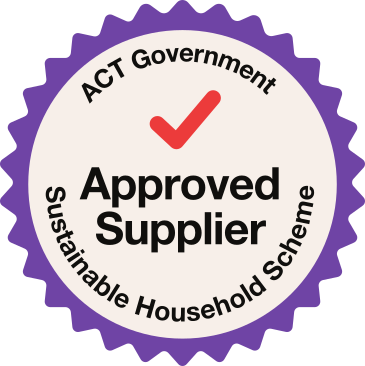The True Cost of Solar Battery in Australia: Your Ultimate Guide
As a leading solar system installer in Australia, we've seen firsthand the growing interest in solar batteries. Homeowners and businesses alike are looking to maximise their solar investment, achieve greater energy independence, and hedge against rising electricity prices. But before diving in, a crucial question arises: what is the actual cost of solar battery storage in Australia?
This comprehensive guide will break down the expenses, explore the influencing factors, discuss the benefits, and help you determine if a solar battery is a worthwhile investment for your Australian property.
1. Understanding the Cost of Solar Battery: An Overview
The cost of solar battery in Australia can range significantly, typically from $8,000 to $20,000, including both the battery unit and installation. This wide range reflects the diverse options available in terms of capacity, brand, technology, and installation complexity. A smaller 6kWh battery might cost around $10,000-$14,000, while a larger 10-14kWh unit could be $15,000-$20,000.
Get Quick Quote
Under No Obligation
2. Key Components Contributing to the Cost of Solar Battery
When assessing the cost of solar battery, it's important to understand what makes up the total price:
- Battery Unit: This is the core component, and its price is primarily driven by its storage capacity (measured in kilowatt-hours or kWh) and the brand.
- Inverter (Hybrid/Battery-Ready): If you're adding a battery to an existing solar system, you might need a hybrid inverter or a battery-ready inverter that can manage both solar generation and battery charging/discharging.
- Installation Fees: Labour costs for electricians and solar installers, including wiring, mounting, and system integration.
- Additional Equipment: This can include cabling, switchboard upgrades, and any necessary monitoring systems.
- Blackout Protection (Optional): If you desire backup power during grid outages, additional components and specific wiring are often required, adding to the overall cost.
3. Factors Influencing the Cost of Solar Battery
Several key factors directly impact the ultimate cost of solar battery for your home or business:
- Battery Capacity (kWh): This is the most significant determinant. The larger the storage capacity, the higher the price. Your household's daily energy consumption will dictate the ideal capacity.
- Battery Chemistry: Lithium-ion (Li-ion) batteries, particularly Lithium Iron Phosphate (LFP), are the most common and generally offer the best performance and longevity, but come at a higher price point than older technologies like lead-acid.
- Brand and Model: Premium brands like Tesla, LG Chem, and Sonnen typically have higher price tags compared to other reputable manufacturers.
- Inverter Compatibility: If your existing solar inverter isn't battery-ready, you'll need to upgrade to a hybrid inverter, which adds to the expense.
- Installation Complexity: Factors like roof type, accessibility, distance from the main switchboard, and any required electrical upgrades can influence installation labour costs.
- Location in Australia: Regional differences in labour costs and supply chain logistics can slightly impact the overall price.
- Government Incentives & Rebates: These can significantly reduce the upfront cost of solar battery, making it more accessible.
4. Average Cost of Solar Battery by Capacity
Here's a general guide to the average cost of solar battery units based on common capacities in Australia (excluding installation, which typically adds $1,500-$5,000):
- 5-7 kWh: Approx. $5,000 - $9,000
- 8-10 kWh: Approx. $9,000 - $14,000
- 11-14 kWh: Approx. $14,000 - $18,000+
Note: These are indicative prices and can fluctuate based on market conditions and specific products.
5. Installation Cost of Solar Battery
The installation cost of solar battery typically ranges from $3,000 to $5,000. This covers:
- Labour: Highly skilled electricians and solar technicians are required for safe and compliant installation.
- Mounting and Wiring: Securely installing the battery unit and connecting it to your solar system and home's electrical panel.
- System Commissioning: Ensuring the battery system is correctly configured and communicating with your solar inverter and monitoring platform.
- Permits and Inspections: Necessary approvals from local authorities.
6. Hybrid Systems vs. Retrofit Battery Installation
When considering the cost of solar battery, it's important to distinguish between new hybrid solar systems and retrofitting a battery to an existing system:
- New Hybrid System: If you're installing a new solar system with a battery, a hybrid inverter will be integrated from the start. This can be more cost-effective as it streamlines installation and component compatibility. A 6.6kW solar system with a 10kWh battery can cost anywhere between $16,000 – $21,000.
- Retrofit: Adding a battery to an existing solar system might require a new hybrid inverter if your current inverter isn't compatible. This can add an extra $2,000-$4,000 to the total cost of solar battery installation.
7. Major Solar Battery Brands and Their Cost in Australia
Australia's solar battery market is robust, with several leading brands offering different features and price points. Some popular options include:
- Tesla Powerwall: Known for its high capacity and integrated inverter, the Powerwall 2 (13.5kWh) is a premium option, typically costing around $11,700 for the unit (before installation and any rebates). The new Powerwall 3 offers similar capacity.
- LG Energy Solution (formerly LG Chem RESU): Offers a range of capacities and is a popular choice for its reliability. A 9.8kWh LG Chem RESU battery might cost around $8,000 (unit only).
- Alpha ESS: Provides a variety of hybrid and AC-coupled battery solutions.
- BYD Battery-Box: Offers modular and scalable battery solutions, making them flexible for various energy needs.
- Sungrow: A well-known inverter manufacturer that also offers competitive battery solutions.
- Goodwe: Another inverter brand with a growing presence in the battery market.
- Enphase: Offers modular microinverter-based battery solutions for flexibility and redundancy.
The cost of solar battery from these brands can vary significantly, so it's always recommended to get detailed quotes from accredited installers.
8. Government Incentives and Rebates: Reducing the Cost of Solar Battery
Australia offers various incentives that can significantly reduce the cost of solar battery:
- Federal Government's Cheaper Home Batteries Program (effective July 1, 2025): This national initiative offers an upfront discount of approximately 30% or up to $372 per usable kWh of battery capacity. This could mean savings of around $4,000 off a typical 11.5 kWh battery.
- Small-scale Technology Certificates (STCs): While primarily for solar panels, the expansion of the SRES scheme now includes battery installations under the "Cheaper Home Batteries Program."
- State and Territory Rebates: Several states and territories offer additional incentives, which can often be stacked with the federal rebate. Examples include:
- NSW Empowering Homes Program
- WA Home Battery Scheme
- VIC Solar Battery Interest-Free Loan
- NT Battery Scheme
These rebates are crucial in improving the return on investment for solar batteries.
9. Understanding Payback Period and ROI for Solar Batteries
The payback period for a solar battery system depends on the initial cost of solar battery, your electricity consumption patterns, electricity tariffs, and available rebates. In the absence of incentives, payback periods typically range from 7 to 12 years. However, with the new federal rebates, this can be shortened to as little as 4-5 years for some households.
Factors that accelerate ROI include:
- High Night-Time Electricity Usage: Maximising the use of stored solar energy during peak tariff periods.
- Time-of-Use (ToU) Tariffs: Shifting consumption to cheaper off-peak hours by using battery power during expensive peak times.
- Lower Feed-in Tariffs (FiTs): When FiTs are low, storing and self-consuming your solar power becomes more financially beneficial than exporting it to the grid.
10. Benefits Beyond Cost Savings: Why Invest in a Solar Battery?
While the cost of solar battery is a primary consideration, the benefits extend beyond just financial savings:
- Increased Self-Consumption: Store excess solar energy generated during the day and use it at night, significantly reducing your reliance on grid electricity.
- Energy Independence: Reduce your vulnerability to grid instability and rising electricity prices.
- Blackout Protection: Many batteries offer a backup power feature, keeping essential appliances running during grid outages.
- Environmental Impact: Further reduce your carbon footprint by maximising your use of clean, renewable energy.
- Virtual Power Plant (VPP) Participation: In some areas, you can join a VPP, allowing your battery to contribute to grid stability and potentially earn you additional income.
- Peak Shaving: Reduce your demand from the grid during expensive peak hours, lowering your electricity bills.
- Increased Property Value: Homes with solar and battery storage are increasingly attractive to buyers.
11. Sizing Your Solar Battery: How Much Capacity Do You Need?
The ideal battery size depends on your daily electricity consumption, particularly during non-daylight hours. The average Australian household consumes around 18-25 kWh per day.
- Smaller homes/low consumption: 5-7 kWh battery.
- Medium homes/average consumption: 8-10 kWh battery.
- Larger homes/high consumption/EV charging: 10-14+ kWh battery.
A detailed energy audit by a professional installer will help determine the optimal battery size for your specific needs, balancing the cost of solar battery with your desired energy independence.
12. Maintenance and Lifespan of Solar Batteries
Modern solar batteries, primarily lithium-ion, are designed for longevity with minimal maintenance.
- Lifespan: Most solar batteries come with a 10-year warranty and are expected to last 10-15 years, or even longer (5,000-10,000 cycles).
- Maintenance: Generally low. Regular solar system inspections (every 1-2 years, costing $150-$300) should include a check of the battery system. Keeping the battery in a well-ventilated area away from direct sunlight can help prolong its life.
- Degradation: Like all batteries, solar batteries experience gradual capacity degradation over time. Warranties typically guarantee a certain percentage of original capacity (e.g., 70-80%) after 10 years.
13. Off-Grid vs. On-Grid with Battery Storage
The cost of solar battery for off-grid systems is generally higher due to the need for larger capacities and more robust infrastructure to ensure complete energy independence.
- On-Grid (Grid-Tied with Battery): Most common. You remain connected to the grid, drawing power when your solar and battery can't meet demand and exporting excess power when your battery is full.
- Off-Grid: Complete reliance on your solar and battery system. A typical off-grid system for a 2-3 person home can range from $25,000-$35,000, with the battery being the largest expense.
14. Is the Cost of Solar Battery Worth It in Australia?
With falling battery prices, increasing electricity costs, and new federal and state rebates, the financial case for solar batteries in Australia is becoming increasingly compelling. Beyond the financial returns, the added benefits of energy independence, blackout protection, and environmental contribution make solar batteries a highly valuable investment for many Australian households and businesses.
15. The Impact of Feed-in Tariffs on Battery Value
Lower solar feed-in tariffs (FiTs) have actually increased the attractiveness of solar batteries. When the amount you get paid for exporting excess solar energy back to the grid is low, it makes more financial sense to store that energy in a battery for your own use, especially during peak electricity price periods. This maximises your self-consumption and reduces your reliance on purchasing expensive grid electricity.
16. Future Trends in Solar Battery Costs
The cost of solar battery technology is expected to continue its downward trend, driven by:
- Technological Advancements: Ongoing research and development are leading to more efficient and cheaper battery chemistries and manufacturing processes.
- Increased Production Scale: As demand for solar batteries grows globally, mass production will further reduce unit costs.
- Strong Competition: A competitive market with many players vying for market share will continue to drive prices down.
17. The Role of Smart Energy Management Systems
Modern solar batteries often come integrated with smart energy management systems (BMS - Battery Management Systems). These systems allow you to monitor your energy usage, solar production, and battery status in real-time via smartphone apps. This data helps you optimise your energy consumption and maximise the financial benefits of your solar battery system. Some systems also allow for "virtual power plant" (VPP) participation.
18. Choosing the Right Installer
Selecting an experienced and accredited solar battery installer is crucial. Ensure they:
- Are Clean Energy Council (CEC) accredited.
- Have a strong track record and positive customer reviews.
- Offer a comprehensive warranty on both the product and installation.
- Provide a detailed quote that clearly outlines the cost of solar battery components and installation.
- Can assess your specific energy needs and recommend the most suitable battery system.
19. Frequently Asked Questions (FAQs) about the Cost of Solar Battery
Q1: What is the average cost of solar battery installation in Australia? A1: The average total cost of solar battery installation in Australia, including the battery unit, typically ranges from $8,000 to $20,000, depending on capacity and brand. Installation fees alone are usually between $3,000 and $5,000.
Q2: How much can a solar battery save me on electricity bills? A2: Savings vary significantly based on your energy consumption, electricity tariffs, and battery size. Households with solar + battery systems can save an estimated $800–$2,300 per year by offsetting grid energy costs, especially when utilising time-of-use tariffs.
Q3: Are there government rebates for solar batteries in Australia? A3: Yes, from July 1, 2025, the Federal Government's Cheaper Home Batteries Program will offer significant rebates (up to 30% or $372/kWh). This can be stacked with various state and territory incentives.
Q4: How long do solar batteries last? A4: Most modern lithium-ion solar batteries have a warranty of 10 years and are expected to last for 10-15 years or more, with many offering 5,000 to 10,000 charge cycles.
Q5: Can I add a solar battery to my existing solar system? A5: Yes, in many cases, you can retrofit a solar battery to an existing system. However, you might need to upgrade your inverter to a hybrid or battery-ready model, which adds to the total cost of solar battery installation.
Q6: Does a solar battery provide blackout protection? A6: Many solar batteries offer blackout protection, allowing you to power essential appliances during a grid outage. It's crucial to confirm this feature with your installer as not all batteries provide it as standard.
20. Conclusion: Investing in Your Energy Future
The cost of solar battery in Australia is a significant investment, but one that offers substantial long-term benefits. From drastically reducing your electricity bills and achieving greater energy independence to providing peace of mind during blackouts, solar batteries are increasingly becoming an integral part of a sustainable and cost-effective energy strategy for Australian homes and businesses.
With new federal and state incentives set to significantly lower the upfront costs, now is an opportune time to explore adding a solar battery to your system.
Ready to explore the possibilities of solar battery storage for your property?
Contact our team of expert solar system installers today for a personalised consultation and a detailed quote tailored to your energy needs. Let us help you unlock true energy independence and start saving on your electricity bills!



